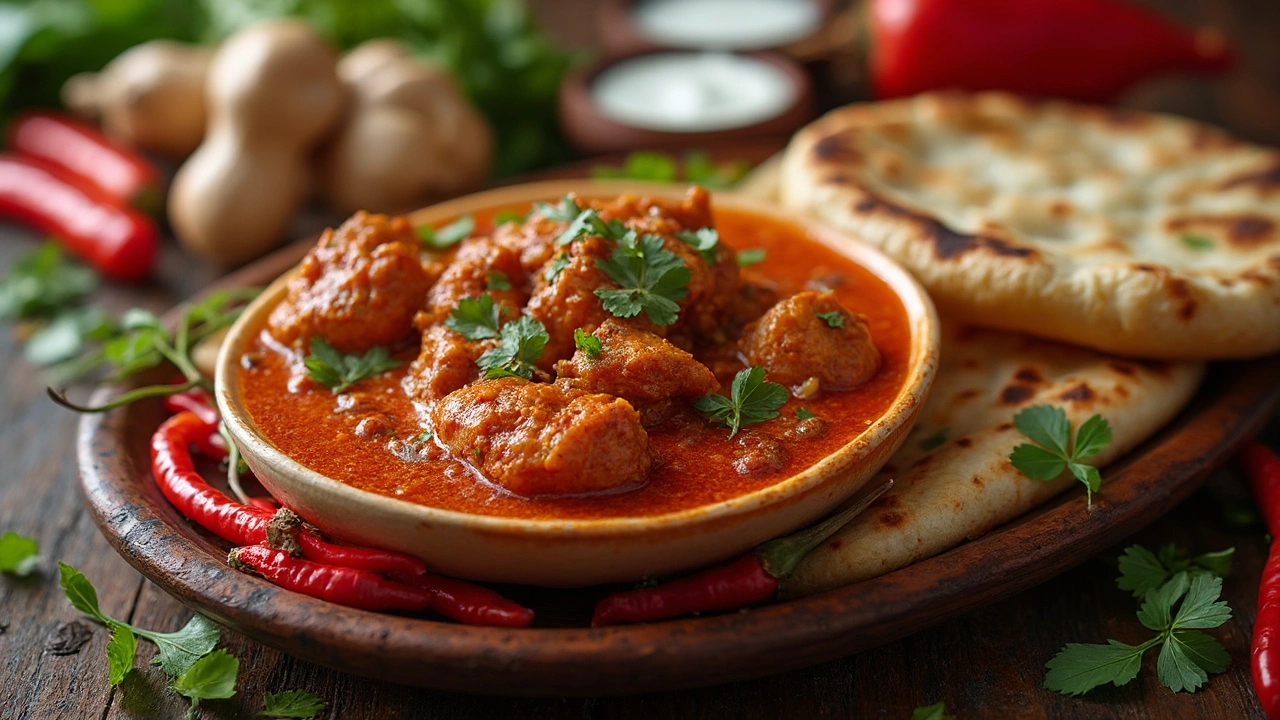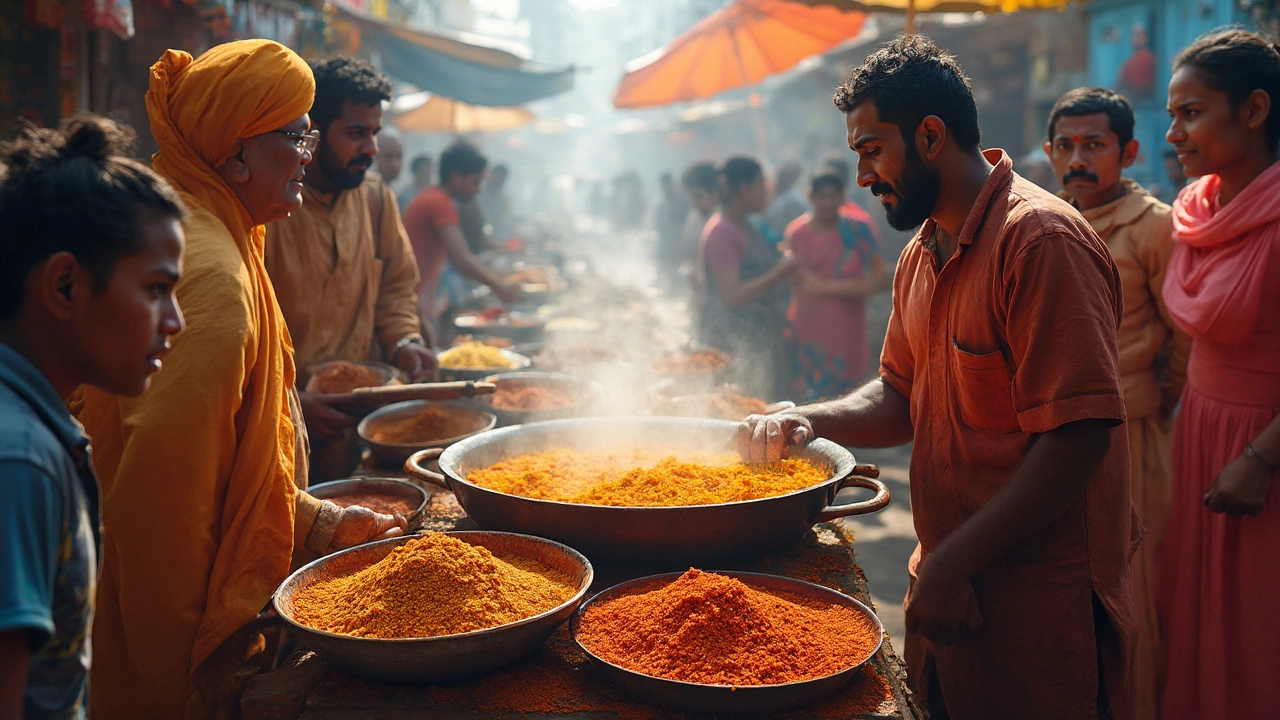Ever wondered which Indian curry could bring tears to your eyes and flames to your mouth? Meet Phaal Curry, the notorious fiery delight that’s become a challenge for spice lovers worldwide. Originally whipped up in Indian restaurants in the UK, this curry isn't messing around when it comes to heat.
Imagine taking a spoonful and suddenly feeling like you're on a feverish rollercoaster at midday in the desert. Just thrilling, right? Well, that's Phaal for you. It's crafted with some of the hottest chilies known to humankind, making it one undeniable heat wave on a plate. Curious about what goes into making this tongue-tingling dish? Hold on to your napkins, because we're diving into those burning details next!
- Introduction to Phaal Curry
- Origin and Popularity
- Ingredients That Set It on Fire
- The Heat Challenge Experience
- Tips for Handling the Spice
- Exploring Other Spicy Curries
Introduction to Phaal Curry
So, you’re curious about the famed Phaal Curry? Grab a glass of milk, because this dish is not for the faint-hearted. Dubbed the hottest curry you can order on this planet, it’s a notorious challenge in any Indian food joint where it appears on the menu.
Though you'd think it's straight from the streets of India, it’s actually a creation hailing from Indian restaurants in the melting pot of cultures that is the UK. Chefs there took inspiration from traditional spicy Indian curries and cranked the heat up several notches, resulting in a dish that’s dare-worthy.
What makes Phaal Curry notorious isn't just its spiciness but the bravado surrounding it. It's often peppered with the world's fieriest chilies like Bhut Jolokia and Scotch Bonnets. These chilies pack a Scoville scale punch that’ll have even the bravest of souls reaching for the nearest fire extinguisher.
As you delve into how this curry is made and why it's both loved and feared, keep in mind that it’s not just about surviving the heat but savoring the flavor. Despite the intense fiery personality, true curry lovers swear by its rich taste layered under all that heat. Ready to find out if you're up to the challenge?
Origin and Popularity
The fiery Indian curry known as Phaal has an interesting backstory. It didn't actually originate in India as you might expect. Instead, it was the creativity of chefs in Indian restaurants in the UK who wanted to cater to the adventurous taste buds of British diners. It's like the culinary wild child of Indian cooking, pushing boundaries with its intense heat.
So why did it become so popular? Well, apart from its searing spiciness, it became something of a spice test or a bragging right. It's like having a trophy for the toughest taste buds, a badge of honor among those craving culinary excitement. And it’s particularly popular when people are looking to out-spice one another or when restaurants create challenges around eating the hottest dish on the menu.
Because of its notorious heat level, Phaal has made its way into spicy food challenges and has been featured in food shows globally. It has etched its place in street food India, not just due to its heat but also because it plays on curiosity and adventurous eating. In many eateries, conquering a Phaal can get your name on the wall or a free drink to douse the flames — pretty neat, huh?
Here's a tip: If you're planning to try Phaal Curry yourself, make sure you know what you're getting into. The adventure is as much about the bragging rights as the taste. Who wouldn't want to say they've tackled this beast of a dish?
Ingredients That Set It on Fire
When it comes to creating the infamous Phaal Curry, it's all about those scorching ingredients that can make even the bravest diners break a sweat. The heart of this fiery dish lies in its deadly chili lineup. Forget your regular red chili powder; Phaal takes it up a notch with a selection that might include the Bhut Jolokia, also known as the ghost pepper, alongside the habanero and scotch bonnet peppers. These chilies are not just spicy; they are the kind of spicy that makes you question your life choices.
Beyond these tongue-scorching chilies, Phaal Curry features a medley of spices that add depth and flavor amidst the heat. You’ll find the likes of turmeric, cumin, coriander, and garam masala. These spices don’t just bring flavor; they form a support system for the chilies, enhancing the overall taste without overshadowing the main fiery stars.
What’s interesting is how chefs balance such intense heat with a hint of sweetness. In some recipes, you might find ingredients like tomatoes and onions cooked down to a rich base that complements the heat. The sweetness of caramelized onions can provide a brief respite from the spiciness.
Occasionally, Phaal Curry might also contain a splash of vinegar or lemon juice, introducing a tang that cuts through the fiery richness, allowing the dish to have more complexity rather than just overwhelming heat.
Wondering what kind of punch this pack has? Let's take a look at a simple heat comparison:
| Chili Type | Scoville Rating |
|---|---|
| Ghost Pepper | 850,000 - 1,041,427 |
| Habanero | 100,000 - 350,000 |
| Scotch Bonnet | 100,000 - 350,000 |
So, whenever someone orders a Phaal, they are stepping into a culinary battlefield armed with these 'set-it-on-fire' ingredients that aren't just there to make you sweat but to give you a memorable taste sensation. It’s not just about the spicy curry; it's about embracing the extreme and enjoying every fiery moment.

The Heat Challenge Experience
So, you're considering diving into the world of Phaal Curry? Brace yourself, because this isn't your typical curry experience. The heat challenge has attracted spicy food aficionados from all corners of the globe. It’s not just about eating; it's about survival and pride.
Restaurants in various parts of the UK have turned this into a rite of passage for daring diners. They serve Phaal with the very intention of seeing who can conquer it. And let me tell you, it’s no easy feat. The goal is simple: clear your plate without waving the white flag or reaching for a milkshake too soon.
The challenge often involves signing a waiver (seriously!) acknowledging that you’re eating at your own risk. This is partly because the key ingredients include a mix of some of the hottest chili peppers, like Bhut Jolokia and Naga Viper, known to be at the top of the Scoville scale.
Curious how diners handle it? Many can't help but cry or sweat bullets while eating. But those who manage to finish it wear their bragging rights proudly. Some restaurants even reward them with certificates or have their photo displayed on a 'Wall of Fame'.”
If you're thinking of taking the challenge, here's a little tip: come prepared. Avoid eating anything too spicy in the days leading up to the challenge to keep your taste buds fresh and ready. Also, steer clear of carbonated drinks that could aggravate the heat. Water, while seemingly helpful, often spreads the capsaicin around, which can intensify the burn. Instead, opt for milk-based drinks when the going gets tough.
Tips for Handling the Spice
Feeling brave enough to tackle the fiery beast that is Phaal Curry? Awesome! But before you do, it’s a good idea to arm yourself with a few tried-and-true tips to make the experience a bit less, well, scorching. Let's break it down so you can savor the heat instead of being overwhelmed by it.
First up, always have something dairy-based on standby—milk or yogurt are lifesavers. The calcium in dairy products can help neutralize capsaicin, which is the stuff in chilies that sets your mouth on fire. Renowned chef Vijay Kumar once said,
"A spoonful of yogurt can be your best friend against a fiery curry."Trust a chef who's spent years perfecting the balance of flavors in Indian cuisine!
Also, pace yourself. Instead of digging right in and shoveling a whole spoonful into your mouth, take it slow. Let your taste buds adjust to the spice level. If it's too hot right away, you might find yourself missing out on some delicious nuances hidden beneath the heat.
- Starch it Out: Bread or rice can help soak up some of the spiciness. This isn’t just a filler; it’s a smart move.
- Sip Something Sweet: A sweet drink can counteract that fiery sensation since sugar tends to dampen spice. Think mango lassi, not soda.
- Don't Chug Water: Water might seem like a good idea, but it can actually spread the heat around your mouth instead of calming it. Yikes!
And hey, remember to breathe. Literally. Taking slow breaths can surprisingly help you stay calm while your mouth feels like it's on a thrilling adventure. And who knows? With these little tricks, you might just become a fan of the hottest Indian curry around!
Exploring Other Spicy Curries
If you think Indian curry starts and ends with Phaal, you're in for a surprise. India genuinely loves its heat, and there are several other spicy dishes that proudly hold the fort when it comes to turning up the heat.
Let’s talk about Vindaloo. This spicy curry has roots in the Goan region and has become famous worldwide for being a fiery experience. Vindaloo traditionally combines pork with vinegar and dried red chilies, making it hot enough to wake up your taste buds with a punch. Its spicy legacy owes much to the Portuguese, who brought over the vinegar and garlic base.
Next on our spicy tour is Laal Maas, a Rajasthani delicacy. This is a meat curry that's all about red chilies—clearly not holding back on the heat. The curry showcases the powerful and distinctive flavors of Mathania chilies, making it a favorite among those who can handle its fiery nature.
Another interesting contender is the Chettinad Curry, hailing from Tamil Nadu. This dish creates its spicy symphony with a special blend of peppercorns and chilies, along with a medley of other spices like fennel seeds and cumin. The pepperiness here is no joke, giving it a robust flavor that spice lovers can’t resist.
And let's not forget the fiery Bhut Jolokia, known as the ghost chili. Curries made with this chili, like Naga Curry, rarely leave anyone without a story of how they "survived" it. Considered one of the hottest chilies globally, it's a key player if you're chasing the thrill of high heat.
Dozens of other spicy experiences await, each with their regional twist and spice blend. So, if Phaal Curry is just a starting point for your spicy adventure, the world of street food India holds even more challenges to tickle—or rather, scorch—your palate.
